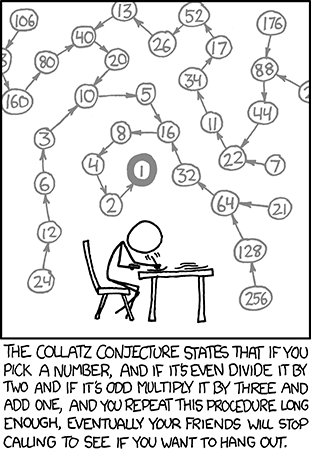CS 200 - Fall 2024.
[Home]
Welcome to CS 200!
Video of the Day
Python: Trailer from Socratica
Python: Hello World from Socratica
Image of the Day

(See Wednesday's logical problem.)
Also, story behind the python antigravity module.
Logical problem of the day: 12, 6, 3, 10, 5, ...
What is the next number in the above series?
https://pollev.com/slade
You may also download the app to your phone. Use the "slade" poll id.
Canvas Quiz of the Day (need daily password)
Most days, there will be a simple canvas quiz related to the lecture.
You need a password to activate the quiz, which I will provide in class.
These quizzes will count toward your class participation grade.
The quiz is available only during class.
Click for today's quiz.
Note: the collaboration quiz is separate. It coincides with the first homework assignment.
Lecture 1: Python. 8/30
If you're thinking of taking
CPSC 200, please do the following.
Complete
this online Student Information form.
Get a course account for CPSC 200 on the Zoo. When you register for
this class, your course account should be created within one hour or
so of signing up.
Start the reading assignment:
[Assignments]. Demo hw0.py
Familiarize yourself with the Zoo computers
by attending a (soon-to-be-scheduled) Zoo help session,
or with classmates or on your own using the
Zoo tutorial, Spring 2014 edition.
(Optional.) Download and install Python on your computer
(Python)
and familiarize yourself with it.
If you don't want to install and run Python on your machine,
you may run it in person or remotely using your Zoo account.
Note that there are two current versions of Python: 2 and 3, which
are not quite compatible. We suggest that you opt for version 3.
Collatz Conjecture
 Want to win a Fields Medal? Solve the
Collatz Conjecture! (aka, Kakutani's Problem).
Want to win a Fields Medal? Solve the
Collatz Conjecture! (aka, Kakutani's Problem).
We define a function collatz(n) (where n is an
arbitrary positive integer) which behaves as follows:
- If n is even, return n/2.
- If n is odd, return 3n + 1.
Next, let's define a sequence of Collatz numbers, such that the output
of each call becomes the input of the next, unless and until you
arrive at 1. The conjecture part is to prove that this series will
always converge to 1.
We now turn to some python code that implements Collatz
collatz.py
Getting to know Python
Introduction.html (jupyter) Python
Getting to know UNIX
UNIX Introduction
[Home]


 Want to win a Fields Medal? Solve the
Collatz Conjecture! (aka, Kakutani's Problem).
Want to win a Fields Medal? Solve the
Collatz Conjecture! (aka, Kakutani's Problem).